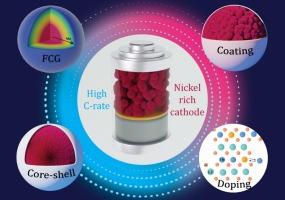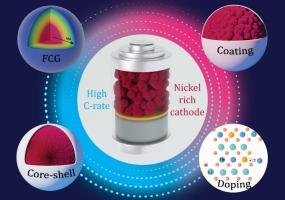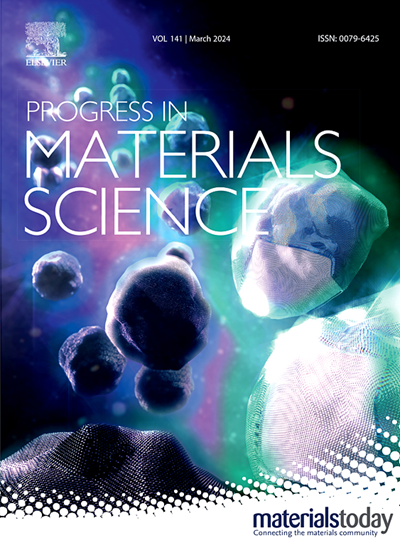先进的策略,促进可持续的高速率富镍阴极到耐用的锂离子电池
IF 40
1区 材料科学
Q1 MATERIALS SCIENCE, MULTIDISCIPLINARY
引用次数: 0
摘要
高性能锂离子电池(lib)需求的快速增长凸显了高倍率富镍阴极材料的重要性,这是迈向下一代锂离子电池的关键一步,具有高放电容量、更高的能量密度、稳定的工作电压和成本效益。然而,诸如阳离子混合、副反应、微裂纹形成和热不稳定性等问题限制了它们的速率能力和长期耐久性。本综述对这些挑战进行了详细的评估。它概述了克服它们的策略,包括表面涂层,掺杂,核壳结构,全浓度梯度以及颗粒或添加剂工程。表面涂层提高了表面稳定性和离子输运,而掺杂方法,包括柱和梯度掺杂,减少了阳离子混合,增强了结构稳定性。核壳梯度和全浓度梯度设计减轻了机械应力,抑制了相变,先进的颗粒工程减少了微裂纹的形成。密度泛函理论和机器学习等计算工具,以及现场表征,为降解机制提供了有价值的见解,从而实现了更精确的材料优化。重要的是,整合多种策略的组合和改进方法显示出解决这些挑战的最大潜力,同时保持可持续性和可扩展性。这项工作澄清了操作机制,帮助研究人员开发先进的高速率富镍阴极锂电池,用于未来的能源存储。本文章由计算机程序翻译,如有差异,请以英文原文为准。


Advanced strategies to boost sustainable high-rate Ni-rich cathodes toward durable LIBs
The rapid rise in demand for high-performance lithium-ion batteries (LIBs) highlights the importance of high-rate nickel-rich cathode materials as a key step toward next-generation LIBs, offering high discharge capacity, increased energy density, stable operating voltage, and cost-effectiveness. However, issues such as cation mixing, side reactions, microcrack formation, and thermal instability limit their rate capability and long-term durability. This review provides a detailed assessment of these challenges. It outlines strategies to overcome them, including surface coating, doping, core–shell structures, full-concentration gradients, and particle or additive engineering. Surface coatings improve surface stability and ion transport, while doping methods, including pillar and gradient doping, reduce cation mixing and strengthen structural stability. Core–shell and full-concentration gradients designs relieve mechanical stress and suppress phase transitions, and advanced particle engineering reduces microcrack formation. Computational tools such as density functional theory and machine learning, together with in-situ characterization, provide valuable insights into degradation mechanisms, enabling more precise material optimization. Importantly, combined and modified approaches that integrate multiple strategies show the greatest potential to address these challenges while maintaining sustainability and scalability. This work clarifies operational mechanisms, aiding researchers in developing advanced high-rate Ni-rich cathode LIBs for future energy storage.
求助全文
通过发布文献求助,成功后即可免费获取论文全文。
去求助
来源期刊

Progress in Materials Science
工程技术-材料科学:综合
CiteScore
59.60
自引率
0.80%
发文量
101
审稿时长
11.4 months
期刊介绍:
Progress in Materials Science is a journal that publishes authoritative and critical reviews of recent advances in the science of materials. The focus of the journal is on the fundamental aspects of materials science, particularly those concerning microstructure and nanostructure and their relationship to properties. Emphasis is also placed on the thermodynamics, kinetics, mechanisms, and modeling of processes within materials, as well as the understanding of material properties in engineering and other applications.
The journal welcomes reviews from authors who are active leaders in the field of materials science and have a strong scientific track record. Materials of interest include metallic, ceramic, polymeric, biological, medical, and composite materials in all forms.
Manuscripts submitted to Progress in Materials Science are generally longer than those found in other research journals. While the focus is on invited reviews, interested authors may submit a proposal for consideration. Non-invited manuscripts are required to be preceded by the submission of a proposal. Authors publishing in Progress in Materials Science have the option to publish their research via subscription or open access. Open access publication requires the author or research funder to meet a publication fee (APC).
Abstracting and indexing services for Progress in Materials Science include Current Contents, Science Citation Index Expanded, Materials Science Citation Index, Chemical Abstracts, Engineering Index, INSPEC, and Scopus.
 求助内容:
求助内容: 应助结果提醒方式:
应助结果提醒方式:


